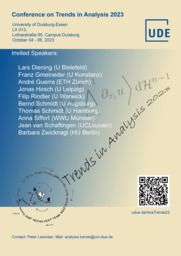The Euler equation of incompressible flows \[ \left\{ \begin{aligned} \nabla \cdot \mathbf{v} &= 0\\ \mathbf{v}_t + \mathbf{v} \cdot \nabla \mathbf{v} &= -\nabla p, \end{aligned} \right. \] has in two dimensions singular solutions, where the vorticity is the sum of Dirac’s masses. The position of the vortices is governed by a Hamiltonian system. The solutions are solutions in the sense of distributions.
With Didier Smets, we have shown that some solutions could be approximated by stationnary classical solutions. We construct the velocity field as \(\nabla \psi^\perp\), where \[ \left\{ \begin{aligned} -\varepsilon^2 \Delta \psi & = \psi_+^p & & \text{dans \(\Omega\)},\\ \psi&=\psi_0-\frac{\kappa}{2\pi} \ln \frac{1}{\varepsilon} & & \text{sur \(\partial \Omega\)}. \end{aligned} \right. \] and \(\varepsilon \to 0\). We treat the case of a single stationnary vortex and a pair of stationnary vortices in a bounded domain and also the case of a pair of vortices in translation in \(\mathbb{R}^2\).
With S. De Valeriola, we have studied the corresponding problem for vortex rings in axisymmetric three-dimensional flows and for the shallow water equation. In that case, the velocity diverges as \(\log \varepsilon\) at the boundary.
Sébastien de Valeriola and Jean Van Schaftingen, Desingularization of vortex rings and shallow water vortices by a semilinear elliptic problem, Arch. Rat. Mech. Anal. 210 (2013), no. 2, 409–450.
doi:10.1007/s00205-013-0647-3 SharedIt DIAL:136141 arXiv:1209.3988
Didier Smets and Jean Van Schaftingen, Desingularization of vortices for the Euler equation, Arch. Rat. Mech. Anal. 198 (2010), no. 3, 869–925.
doi:10.1007/s00205-010-0293-y SharedIt DIAL:34997 arXiv:0909.1166



